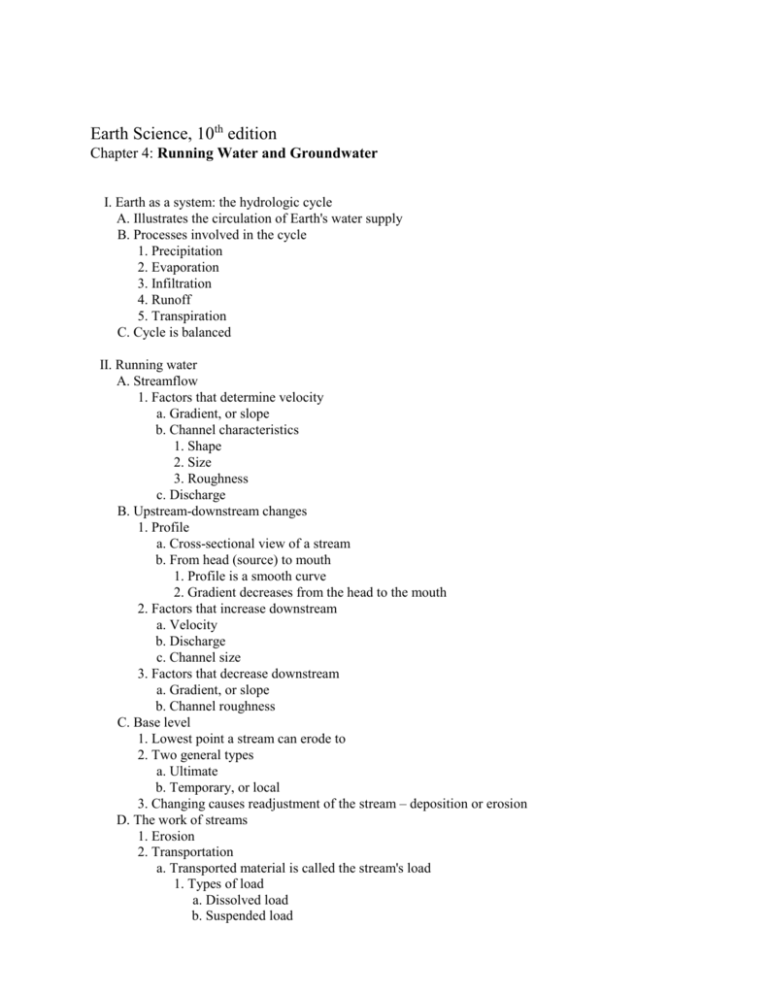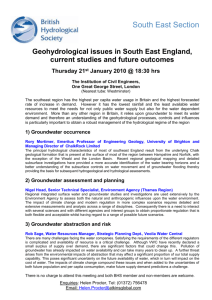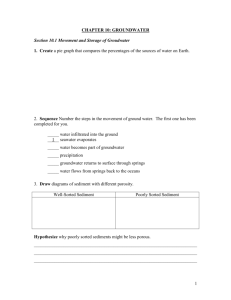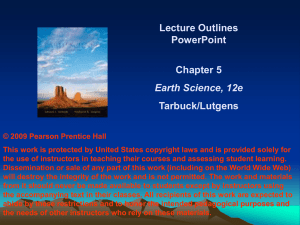Earth Science, 10th edition Chapter 4: Running Water and
advertisement

Earth Science, 10th edition Chapter 4: Running Water and Groundwater I. Earth as a system: the hydrologic cycle A. Illustrates the circulation of Earth's water supply B. Processes involved in the cycle 1. Precipitation 2. Evaporation 3. Infiltration 4. Runoff 5. Transpiration C. Cycle is balanced II. Running water A. Streamflow 1. Factors that determine velocity a. Gradient, or slope b. Channel characteristics 1. Shape 2. Size 3. Roughness c. Discharge B. Upstream-downstream changes 1. Profile a. Cross-sectional view of a stream b. From head (source) to mouth 1. Profile is a smooth curve 2. Gradient decreases from the head to the mouth 2. Factors that increase downstream a. Velocity b. Discharge c. Channel size 3. Factors that decrease downstream a. Gradient, or slope b. Channel roughness C. Base level 1. Lowest point a stream can erode to 2. Two general types a. Ultimate b. Temporary, or local 3. Changing causes readjustment of the stream – deposition or erosion D. The work of streams 1. Erosion 2. Transportation a. Transported material is called the stream's load 1. Types of load a. Dissolved load b. Suspended load c. Bed load 2. Load is related to a stream's a. Competence 1. Maximum particle size b. Capacity 1. Maximum load 2. Related to discharge 3. Deposition a. Caused by a decrease in velocity 1. Competence is reduced 2. Sediment begins to drop out b. Stream sediments 1. Called alluvium 2. Well-sorted deposits c. Features produced by deposition 1. Deltas a. Exist in oceans or lakes b. Distributaries often form in the channel 2. Natural levees a. Form parallel to the stream channel b. Area behind the levees may contain 1. Back swamps 2. Yazoo tributaries E. Stream valleys 1. Valley sides are shaped by a. Weathering b. Overland flow c. Mass wasting 2. Characteristics of narrow valleys a. V-shaped b. Downcutting toward base level c. Features often include 1. Rapids and 2. Waterfalls 3. Characteristics of wide valleys a. Stream is near base level 1. Downward erosion is less dominant 2. Stream energy is directed from side to side b. Floodplain c. Features often include 1. Meanders 2. Cutoffs 3. Oxbow lakes F.Floods and flood control 1. Floods are the most common geologic hazard 2. Causes of floods a. Weather b. Human interference with the stream system 3. Flood control a. Engineering efforts 1. Artificial levees 2. Flood-control dams 3. Channelization b. Nonstructural approach through sound floodplain management G. Drainage basins and patterns 1. A divide separates drainage basins 2. Types of drainage patterns a. Dendritic b. Radial c. Rectangular d. Trellis III. Water beneath the surface (groundwater) A. Largest freshwater reservoir for humans B. Geological roles 1. As an erosional agent, dissolving by groundwater produces a. Sinkholes b. Caverns 2. An equalizer of streamflow C. Distribution and movement of groundwater 1. Distribution of groundwater a. Belt of soil moisture d. Zone of aeration 1. Unsaturated zone 2. Pore spaces in the material are filled mainly with air b. Zone of saturation 1. All pore spaces in the material are filled with water 2. Water within the pores is groundwater c. Water table – the upper limit of the zone of saturation 2. Movement of groundwater a. Porosity 1. Percentage of pore spaces 2. Determines how much groundwater can be stored b. Permeability 1. Ability to transmit water through connected pore spaces 2. Aquitard – an impermeable layer of material 3. Aquifer – a permeable layer of material D. Features associated with groundwater 1. Springs a. Hot springs 1. Water is 6-9C warmer than the mean air temperature of the locality 2. Heated by cooling of igneous rock b. Geysers 1. Intermittent hot springs 2. Water turns to steam and erupts 2. Wells a. Pumping can cause a drawdown (lowering) of the watertable b. Pumping can form a cone of depression in the water table 3. Artesian wells a. Water in the well rises higher than the initial groundwater level b. Types of artesian wells 1. Nonflowing 2. Flowing E. Environmental problems associated with groundwater 1. Treating it as a nonrenewable resource 2. Land subsidence caused by its withdrawal 3. Contamination F. Geologic work of groundwater 1. Groundwater is often mildly acidic a. Contains weak carbonic acid b. Dissolves calcite in limestone 2. Caverns a. Formed by dissolving rock beneath Earth's surface b. Formed in the zone of saturation c. Features found within caverns 1. Form in the zone of aeration 2. Composed of dripstone a. Calcite deposited as dripping water evaporates b. Common features 1. Stalactites hanging from the ceiling 2. Stalagmites developing on the cave floor 3. Karst topography a. Formed by dissolving rock at, or near, Earth's surface b. Common features 1. Sinkholes a. Surface depressions b. Formed by 1. Dissolving bedrock 2. Cavern collapse 2. Caves and caverns c. Area lacks good surface drainage










